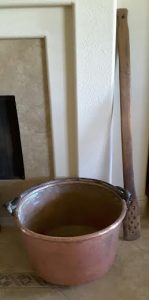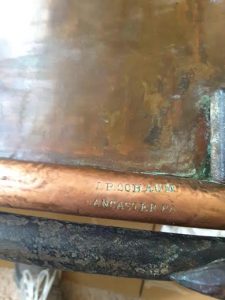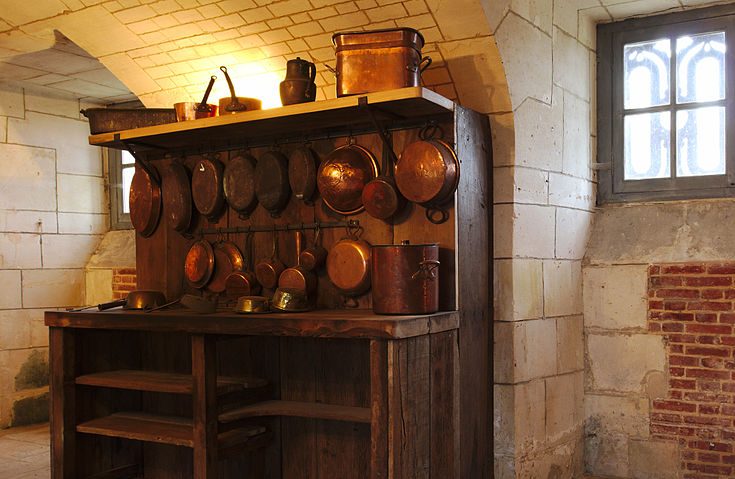Copper Apple Butter Kettle
One summer, Ann Marie and I drove from California to Chicago, and Columbus, Ohio, to visit our children. Emily was working in a Lutheran church camp outside of Chicago, and Nathan was completing an internship at Ohio State University. On our return trip home, we decided to follow Interstate 80, which would take us through Omaha. We were looking forward to sampling some Nebraska fed beef, and we weren’t disappointed in the places we stopped at. One, in particular, Anthony’s, featured prime rib, and the hour-and-half wait was worth it.
Somewhere between Omaha and Grand Island, we decided to take a roadside break, and pulled off the road next to a gas station next to a mini-mart. A few hundred feet away, we spotted a grayish, weather worn building that attested to years of Midwestern weather, days of summer heat, swirling winter snowdrifts, and unforgiving winds. A sign above its entrance simply said, “Antiques.” Surrounding the building were a few broken wagon wheels, some rusted farm machinery, and a faded banner along a wall, “Open 7 Days A Week.” But we had been on the road for a few hours and needed to stretch our legs and look at something besides the highway.
We hadn’t planned on looking for some antiques. Our car was a Ford Probe, and there wasn’t a lot of room left behind the front seats and the trunk. It was already filled with our luggage, my Martin guitar, camera cases, and laptops.

Within a second or two, after walking through the front door, the only thought I had was, “This is what the Count of Monte Cristo must have felt like”. From floor to ceiling the place was filled with a treasure trove of Americana. My second thought was, “Why weren’t we driving a U-Haul today?”
It was supposed to be a brief stop. We spent nearly three hours there. Our decision to buy one or two items finally came down to this: would there be room enough to bring something home? We could not bring back a hoosier, pie pantry, table, church pew, or book case. As we walked around, we came across an oversized copper kettle with a wooden stirring paddle. On the wooden paddle were carved the initials, “JH.” We kept coming back to it. It would be close, I thought, but it might fit in what little room we had left in the car, with some rearranging.
The copper kettle was intriguing for another reason. It just might have a story. Even though I couldn’t find any identifying marks on the kettle, we decided to buy it. As we were checking out, we also saw a stained glass window hanging behind the register. I measured it, and the space in the car, and we bought it as well. The kettle clearly originated in Pennsylvania, and the store’s owner said the window was from a mansion that was dismantled during a redevelopment program in Omaha during the 1960’s.
After we returned home, I turned my attention immediately to the kettle, searching for its story. I was sure there was a story here. I carefully cleaned away years of handling and then, slowly, some markings began to appear. After several more careful rubbings, the rim revealed the kettle’s history. It was marked with the maker’s name: J.P. Schaum ancaster, PA. The “L” was no longer readable.
As it turns out, J.P. Schaum was a highly regarded craftsman, well known throughout Pennsylvania. Following his grandfather and father, he apprenticed as a coppersmith, moved to Philadelphia, and returned to Lancaster in 1854. In a few years, he began his own business, and in 1860 entered into a partnership with another coppersmith named Deaner. Eight years later, in 1868, the partnership was dissolved, and thereafter Schaum began making copper kettles again under his own name.

His skills were recognized at the Centennial Exposition in 1876, at the Franklin Institute, and at the Pennsylvania State Fair in subsequent years. In 1880, his son joined him, but things were changing in America’s kitchens. Smaller wood burning stoves were replacing traditional colonial kitchens, gas ranges were on the horizon, and the size and weight of the kettles were reduced to accommodate the new stoves being introduced. The copper sheathing – imported from England – was also declining, and in 1892, the Schaum’s turned their attention to furniture making, no longer making copper kettles.
By the turn of the twentieth century, the manufacturing of oversize copper kettles ended. New kitchen technologies had been introduced, stoves and ranges were using gas and electricity and required smaller metallic pots and pans, including copper ones. The large, heavy, and cumbersome kettles no longer had a place in the American kitchen.
The stories of antiques are like highways. The stained glass window went from a mansion in Omaha to a corner store along Highway 80; the copper apple butter kettle came from Pennsylvania to the same corner store. We would take their two stories to California, then to Maryland, and eventually to Texas. We don’t know where the road will take them next.
Both pieces are worth considerably more than what we originally paid for them. But its their stories that really makes them priceless.
An apple butter recipe can be found on the following link: https://baltimorepostexaminer.com/lemon-sponge-pie-marshmallow-treats-and-apple-butter-recipe/2013/03/20
Banner photo by Stanzilla is licensed under the Creative Commons Attribution-Share Alike 4.0 International license.

David is a graduate of the University of Washington (BA,MA) and Oregon State University (Ph.D). His interests include astronomy, photography, painting, and baseball. He never travels without his guitar and banjo. He is a veteran, USCG.

